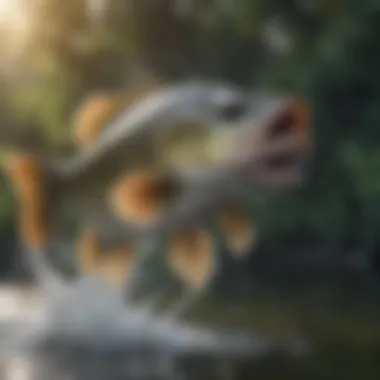Expert Tips on When to Begin Your Bass Fishing Adventure


Overview of the Topic
Understanding the optimal timing for bass fishing is crucial for anglers seeking a successful experience in the waters. This guide delves into the intricacies of when to embark on this fishing adventure, considering factors like seasons, weather patterns, and expert strategies to enhance the fishing journey.
Current State and Challenges
Presently, bass fishing faces challenges due to changing environmental conditions and human activities. Issues such as overfishing, habitat destruction, and pollution have a detrimental impact on bass populations and their habitats, posing threats to the sustainability of this recreational activity.
Sustainable Solutions
To mitigate the challenges facing bass fishing, adopting sustainable practices becomes imperative. Encouraging responsible fishing practices, promoting habitat conservation, and implementing regulations can contribute to the long-term viability of bass populations, ensuring a balanced ecosystem.
Impact and Importance
The impact of bass fishing extends beyond mere recreation, significantly influencing ecosystems, local communities, and future generations. Conservation efforts play a vital role in preserving biodiversity, maintaining ecological balance, and securing the legacy of bass fishing for years to come.
Understanding the Bass Fishing Season
Understanding the Bass Fishing Season is crucial for any angler aiming for a successful fishing experience. By comprehending the seasonal patterns of bass behavior, fishermen can strategically plan their outings to maximize their chances of a good catch. Whether it's the lively spring spawning season or the slow, deep waters of winter, knowing when to expect certain behaviors from bass is key to a fruitful fishing expedition.
Spring Bass Fishing
In the realm of bass fishing, Spring is a time of renewed activity as bass emerge from their winter lethargy. The Optimal Water Temperature during this season triggers the fish to move shallower, actively seeking out warmer waters as a sign of impending spawning. Understanding this temperature range, typically between 55°F to 75°F, helps anglers pinpoint the best locations to find actively feeding bass. While the Pre-Spawn Period sees bass actively feeding to build energy, the Spawn Period marks the peak mating period when bass are more focused on defending nests rather than feeding.
Summer Bass Fishing
As the temperatures rise, Summer brings about unique challenges and opportunities for bass anglers. Early Summer Patterns involve bass moving to shallower areas to feed on baitfish, making it an ideal time for topwater lure action. Midsummer Patterns see bass retreating to deeper, cooler waters during the heat of the day, requiring anglers to target different depths to entice bites. Late Summer Patterns transition into bass feeding heavily in preparation for the upcoming fall, making it a prime time for catching larger, aggressive fish.


Fall Bass Fishing
Transition Period in Fall signifies bass moving from their summer haunts to shallower waters in anticipation of the cooler months. This movement presents opportunities for anglers to intercept transitioning bass around key structures and cover. The Fall Feeding Frenzy is a bass angler's dream, with fish aggressively feeding to store energy for the winter ahead. Understanding the timing and locations of these feeding frenzies can lead to exceptional fishing success.
Winter Bass Fishing
Winter presents a different set of challenges, with bass becoming less active in colder water temperatures. Cold Water Tactics such as slowing down retrieval speeds and targeting deep, slow-moving fish become crucial for enticing bites during winter outings. Deep Water Techniques play a vital role as bass hunker down in the deepest parts of the water body, requiring anglers to adjust their approaches and presentations to match the fish's energy-conserving behavior.
Factors Influencing Bass Activity
Bass activity is profoundly influenced by various factors that anglers need to consider for a successful fishing experience. Understanding these elements is crucial in maximizing the chances of a fruitful catch. By delving into weather conditions, water clarity, bait selection, and presentation, anglers can adapt their strategies accordingly to lure in bass effectively. Factors influencing bass activity serve as the cornerstone for a comprehensive fishing guide.
Weather Conditions
Weather conditions play a pivotal role in determining bass behavior and activity levels. Elements such as temperature, barometric pressure, and wind conditions significantly impact the feeding patterns and movements of bass. Anglers must meticulously analyze these weather components to strategize their fishing approach and increase the probability of a successful outing.
Temperature
Temperature is a key determinant of bass behavior throughout the year. Understanding how temperature influences the metabolism and feeding habits of bass is essential for angling success. Warmer temperatures often trigger active feeding behaviors, while colder temperatures may necessitate adjustments in bait selection and presentation techniques.
Barometric Pressure
Barometric pressure exerts a notable influence on bass activity. Changes in barometric pressure can affect the depth at which bass are likely to be found and their willingness to feed. Anglers should pay close attention to barometric pressure trends when planning their fishing trips to optimize their chances of catching bass.
Wind Conditions
Wind conditions impact the distribution of bait fish, which in turn affects bass feeding behavior. Understanding how wind patterns influence the movement of prey allows anglers to position themselves strategically for a successful catch. Adjusting casting angles and lure presentation according to wind direction can significantly enhance fishing outcomes.
Water Clarity and Depth


The clarity and depth of the water body are significant factors that influence bass activity. Clear water conditions offer greater visibility, requiring anglers to employ more stealthy approaches and accurate casts. In contrast, stained water may necessitate the use of brighter or noisier lures to attract bass effectively.
Clear Water Fishing
In clear water environments, bass can easily detect artificial lures, making a realistic presentation crucial for enticing bites. Anglers should focus on finesse techniques and natural-looking bait to mimic the forage available to bass in clear water. Maintaining a subtle approach is key to success in clear water fishing scenarios.
Stained Water Fishing
Stained water reduces visibility and necessitates adaptations in fishing strategies. Vibrant-colored lures or baits with increased vibration and noise are often more effective in stained water conditions. Anglers should capitalize on the bass's heightened reliance on other senses besides sight to trigger strikes in murky waters.
Deep Water vs. Shallow Water Fishing
The choice between deep and shallow water fishing is determined by various factors such as season, water temperature, and bass activity levels. Understanding when to target bass in deep or shallow waters can significantly enhance the likelihood of a successful fishing trip. Deep water fishing may be more suitable during hot summer months or in response to specific forage patterns, while shallow water fishing can yield fruitful results during spawning seasons or when bass are actively feeding near the shoreline.
Bait Selection and Presentation
Selecting the right bait and presenting it effectively are critical aspects of successful bass fishing. Matching the hatch, choosing between topwater and bottom baits, and determining the speed of retrieval are all essential considerations for enticing bass to strike. Anglers must adapt their bait selection and presentation techniques based on prevailing conditions to optimize their chances of a productive fishing session.
Matching the Hatch
Matching the hatch involves selecting lures that mimic the natural prey present in the water body. By observing the forage available to bass and selecting bait that closely resembles it, anglers can increase their chances of attracting bites. Understanding the prevailing food sources and adjusting lure choice accordingly is paramount for successful bass fishing.
Topwater vs. Bottom Baits
The decision to use topwater or bottom baits depends on various factors such as water temperature, time of day, and bass feeding behavior. Topwater lures are ideal for inducing surface strikes and creating excitement among bass, while bottom baits excel in targeting bass holding near the lake bottom. Anglers should experiment with both types of baits to determine which is most effective in specific fishing situations.
Slow vs. Fast Retrieval


The speed of lure retrieval can influence bass response, with some bass being more inclined to chase down fast-moving baits while others prefer a slower, more leisurely presentation. Anglers should vary their retrieval speed to gauge bass preferences on a given day and adjust their approach accordingly. Understanding when to employ a slow or fast retrieval technique can mean the difference between a missed opportunity and a successful catch.
Tips for Successful Bass Fishing
When it comes to bass fishing, mastering the art requires a combination of skill, patience, and strategy. In this guide, we delve into the essential tips that can elevate your bass fishing experience from good to great. Understanding the behavior of bass and knowing how to adapt to changing conditions are key elements that can significantly impact your success on the water. By honing these skills, anglers can improve their catch rates and have a more fulfilling fishing journey.
Patience and Persistence
Understanding Bass Behavior
Diving deeper into the world of bass fishing, understanding the behavior of these elusive fish is paramount to success. By grasping how bass interact with their environment, feed, and respond to various stimuli, anglers can tailor their fishing techniques accordingly. Recognizing patterns in bass behavior helps anglers anticipate movements and adjust their strategies for better results. This knowledge enhances the overall fishing experience and increases the likelihood of a successful catch.
Adapting to Changing Conditions
Adaptability is another crucial aspect of successful bass fishing. As nature is ever-evolving, being able to adapt to changing conditions such as weather fluctuations, water clarity shifts, and seasonal variations is essential. Flexibility in strategy and willingness to experiment with different approaches can lead to positive outcomes. Anglers who can adapt swiftly to the conditions at hand are more likely to overcome challenges and capitalize on opportunities, ultimately enhancing their fishing proficiency.
Location and Habitat
Key Areas to Target
Identifying key areas where bass are likely to be present is fundamental for a fruitful fishing expedition. Certain spots, such as underwater structures, points, drop-offs, and vegetation patches, are favored habitats for bass. Targeting these areas increases the chances of encountering active fish and optimizing your catch. By focusing on key locations known to hold bass, anglers can improve their efficiency and productivity on the water, enhancing the overall fishing experience.
Structural Elements
Understanding the structural elements that attract bass is essential for strategic fishing. Bass are inclined to hide and hunt near cover like rocks, fallen trees, submerged vegetation, and docks. Knowing how to effectively navigate and target these structural elements can significantly boost your success rate. By honing your skills in identifying and exploiting structural features that appeal to bass, you can elevate your fishing game and achieve better results.
Equipment and Gear
Rod and Reel Selection
Selecting the right rod and reel combination is a critical decision for bass fishing success. Factors such as rod action, length, reel speed, and line capacity play a vital role in determining the effectiveness of your fishing setup. Choosing the appropriate rod and reel that complements your fishing style and techniques can improve casting accuracy, hook setting, and overall control during the battle with bass. Investing in quality equipment tailored to your preferences enhances the fishing experience and sets the stage for successful outings.
Line and Lure Choices
Deciphering the optimal line and lure options is pivotal in enticing bass to bite. Factors like line strength, visibility, and lure presentation impact your ability to attract and hook bass effectively. Selecting the right line type and lure design based on water conditions, fish behavior, and baitfish presence can make a significant difference in your catch rates. By evaluating the nuances of line and lure choices and adapting them to the fishing environment, anglers can increase their chances of landing that prized bass.



